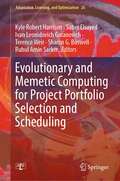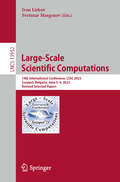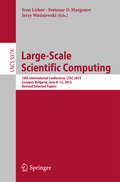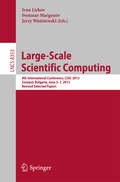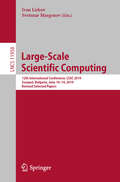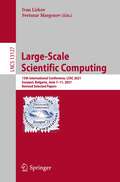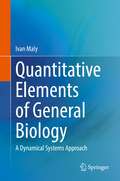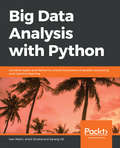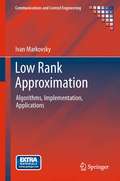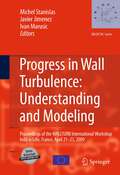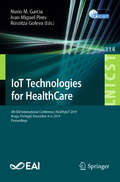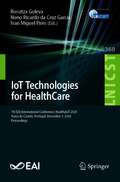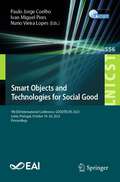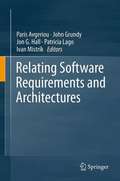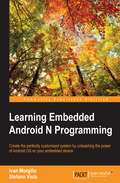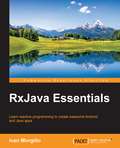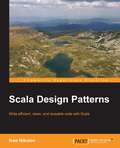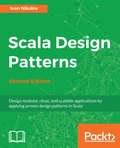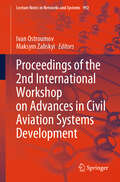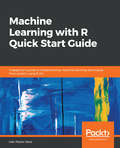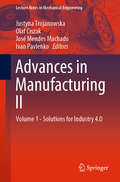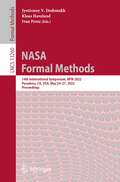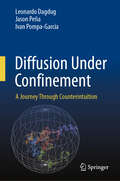- Table View
- List View
Evolutionary and Memetic Computing for Project Portfolio Selection and Scheduling (Adaptation, Learning, and Optimization #26)
by Saber Elsayed Kyle Robert Harrison Ivan Leonidovich Garanovich Terence Weir Sharon G. Boswell Ruhul Amin SarkerThis book consists of eight chapters, authored by distinguished researchers and practitioners, that highlight the state of the art and recent trends in addressing the project portfolio selection and scheduling problem (PPSSP) across a variety of domains, particularly defense, social programs, supply chains, and finance. Many organizations face the challenge of selecting and scheduling a subset of available projects subject to various resource and operational constraints. In the simplest scenario, the primary objective for an organization is to maximize the value added through funding and implementing a portfolio of projects, subject to the available budget. However, there are other major difficulties that are often associated with this problem such as qualitative project benefits, multiple conflicting objectives, complex project interdependencies, workforce and manufacturing constraints, and deep uncertainty regarding project costs, benefits, and completion times.It is well known that the PPSSP is an NP-hard problem and, thus, there is no known polynomial-time algorithm for this problem. Despite the complexity associated with solving the PPSSP, many traditional approaches to this problem make use of exact solvers. While exact solvers provide definitive optimal solutions, they quickly become prohibitively expensive in terms of computation time when the problem size is increased. In contrast, evolutionary and memetic computing afford the capability for autonomous heuristic approaches and expert knowledge to be combined and thereby provide an efficient means for high-quality approximation solutions to be attained. As such, these approaches can provide near real-time decision support information for portfolio design that can be used to augment and improve existing human-centric strategic decision-making processes. This edited book provides the reader with a broad overview of the PPSSP, its associated challenges, and approaches to addressing the problem using evolutionary and memetic computing.
Large-Scale Scientific Computations: 14th International Conference, LSSC 2023, Sozopol, Bulgaria, June 5–9, 2023, Revised Selected Papers (Lecture Notes in Computer Science #13952)
by Ivan Lirkov Svetozar MargenovThis book constitutes the refereed proceedings of the 14th International Conference on Large-Scale Scientific Computations, LSSC 2023, held in Sozopol, Bulgaria, during June 5–9, 2023. The 49 full papers included in this book were carefully reviewed and selected from 61 submissions. They were organized in topical sections as follows: preconditioning and multilevel methods; fractures and mixed dimensional modeling: discretizations, solvers, and methodology; machine learning and model order reduction for large scale predictive simulations; fractional differential problems: theoretical aspects, algorithms and applications; variational analysis and optimal control; stochastic optimal control and numerical methods in economics and finance; tensor methods for big data analytics and low-rank approximations of PDEs solutions; applications of metaheuristics to large-scale problems; large-scale models: numerical methods, parallel computations and applications; HPC and HPDA: algorithms and applications.
Large-Scale Scientific Computing
by Svetozar D. Margenov Ivan Lirkov Jerzy WaśniewskiThis book constitutes the thoroughly refereedpost-conference proceedings of the 10th International Conference on Large-ScaleScientific Computations, LSSC 2015, held in Sozopol, Bulgaria, in June 2015. The 49 revised full papers presented were carefullyreviewed and selected from 64 submissions. The general theme for LSSC 2015 wasLarge-Scale Scientific Computing with a particular focus on the organizedspecial sessions: enabling exascale computation; control and uncertain systems;computational microelectronics - from monte carlo to deterministic approaches;numerical methods for multiphysics problems; large-scale models: numericalmethods, parallel computations and applications; mathematical modeling andanalysis of PDEs describing physical problems; a posteriori error control anditerative methods for maxwell type problems; efficient algorithms for hybridHPC systems; multilevel methods on graphs; and applications of metaheuristicsto large-scale problems.
Large-Scale Scientific Computing
by Ivan Lirkov Svetozar Margenov Jerzy WaśniewskiThis book constitutes the thoroughly refereed post-conference proceedings of the 9th International Conference on Large-Scale Scientific Computations, LSSC 2013, held in Sozopol, Bulgaria, in June 2013. The 74 revised full papers presented together with 5 plenary and invited papers were carefully reviewed and selected from numerous submissions. The papers are organized in topical sections on numerical modeling of fluids and structures; control and uncertain systems; Monte Carlo methods: theory, applications and distributed computing; theoretical and algorithmic advances in transport problems; applications of metaheuristics to large-scale problems; modeling and numerical simulation of processes in highly heterogeneous media; large-scale models: numerical methods, parallel computations and applications; numerical solvers on many-core systems; cloud and grid computing for resource-intensive scientific applications.
Large-Scale Scientific Computing
by Ivan Lirkov Svetozar MargenovThepapersinthis volumewerepresentedatthe4thInternationalConferenceon Large-Scale Scienti'c Computations ICLSSC 2003. It was held in Sozopol, B- garia, June 4-8, 2003. The conference was organized and sponsored by the C- tral Laboratory for Parallel Processing at the Bulgarian Academy of Sciences. Support was also provided from the Center of Excellence "BIS 21" (funded by the European Commission), SIAM and GAMM. A co-organizer of this tra- tional scienti'c meeting was the Division of Numerical Analysis and Statistics of the University of Rousse. The success of the conference and the present volume in particular are the outcome of the joint e'orts of many colleagues from various institutions and organizations. First thanks to all the members of the Scienti'c Committee for their valuable contribution to forming the scienti'c face of the conference, as well as for their help in reviewing contributed papers. We would like to specially thank the organizers of the special sessions: R. Blaheta, N. Dimitrova, A. Ebel, K. Georgiev, O. Iliev, A. Karaivanova, H. Kosina, M. Krastanov, U. Langer, P. Minev, M. Neytcheva, M. Sch] afer, V. Veliov, and Z. Zlatev. We are also grateful to the sta? involved in the local organization. Special Events: - The conference was devoted to the 60th anniversary of Raytcho Lazarov. - During the conference, the nomination for the World Level of the Hall of Fame for Engineering, Science and Technology, HOFEST, was o'cially awarded to Owe Axelsson.
Large-Scale Scientific Computing: 12th International Conference, LSSC 2019, Sozopol, Bulgaria, June 10–14, 2019, Revised Selected Papers (Lecture Notes in Computer Science #11958)
by Ivan Lirkov Svetozar MargenovThis book constitutes revised papers from the 12th International Conference on Large-Scale Scientific Computing, LSSC 2019, held in Sozopol, Bulgaria, in June 2019. The 70 papers presented in this volume were carefully reviewed and selected from 81 submissions. The book also contains two invited talks. The papers were organized in topical sections named as follows: control and optimization of dynamical systems; meshfree and particle methods; fractional diffusion problems: numerical methods, algorithms and applications; pore scale flow and transport simulation; tensors based algorithms and structures in optimization and applications; HPC and big data: algorithms and applications; large-scale models: numerical methods, parallel computations and applications; monte carlo algorithms: innovative applications in conjunctions with other methods; application of metaheuristics to large-scale problems; large scale machine learning: multiscale algorithms and performance guarantees; and contributed papers.
Large-Scale Scientific Computing: 13th International Conference, LSSC 2021, Sozopol, Bulgaria, June 7–11, 2021, Revised Selected Papers (Lecture Notes in Computer Science #13127)
by Ivan Lirkov Svetozar MargenovThis book constitutes revised selected papers from the 13th International Conference on Large-Scale Scientific Computing, LSSC 23021, which was held in Sozopol, Bulgaria, during June 7-11, 2021. The 60 papers included in this book were carefully reviewed and selected from a total of 73 submissions. The volume also includes two invited talks in full paper length. The papers were organized in topical sections as follows: Fractional diffusion problems: numerical methods, algorithms and applications; large-scale models: numerical methods, parallel computations and applications; application of metaheuristics to large-scale problems; advanced discretizations and solvers for coupled systems of partial differential equations; optimal control of ODEs, PDEs and applications; tensor and matrix factorization for big-data analysis; machine learning and model order reduction for large scale predictive simulations; HPC and big data: algorithms and applications; and contributed papers.
Quantitative Elements of General Biology: A Dynamical Systems Approach
by Ivan MalyThis monograph sketches out a broad spectrum of problems (from evolution and metabolism to morphogenesis and biogeographical dynamics) whose solution has been impacted by mathematical models. Each of the selected examples has led to the recognition—and set direction to further study—of certain fundamental but unintuitive properties of biological systems, such as the making and breaking of specific symmetries that underlie morphogenesis. Whether they are long-established or only recently accepted, these models are selected for being thought-provoking and illuminating both the achievements and the gaps in our current understanding of the given area of biology. The selection of models is also meant to bring to the fore the existing degree of unity in the quantitative approach to diverse general-biological questions and in the systems-level properties that are discovered across the levels of biological organization. It is the thesis of this book that further cultivation of such unity is a way forward as we progress toward a general theory of living matter.This is an ideal book for students (in the broadest sense) of biology who wish to learn from this attempt to present the exemplary models, their methodological lessons, and the outline of a unified theory of living matter that is now beginning to emerge. In addition to a doctoral student preparing for quantitative biology research, this reader could also be an interdisciplinary scientist transitioning to biology. The latter—for example, a physicist or an engineer—may be comfortable with the mathematical apparatus and prepared to quickly enter the intended area of work, but desires a broader foundation in biology from the quantitative perspective.
Big Data Analysis with Python: Combine Spark and Python to unlock the powers of parallel computing and machine learning
by Ivan MarinThe audience is expected to know basic statistical measurements (mean, median, standard deviation, and so on), some kinds of graphs (line graph, scatter plot, and so on) and have working knowledge of relational databases. Python programming or other programming language experience is required. Having knowledge about distributed systems and/or Hadoop is useful.
Low Rank Approximation
by Ivan MarkovskyData Approximation by Low-complexity Models details the theory, algorithms, and applications of structured low-rank approximation. Efficient local optimization methods and effective suboptimal convex relaxations for Toeplitz, Hankel, and Sylvester structured problems are presented. Much of the text is devoted to describing the applications of the theory including: system and control theory; signal processing; computer algebra for approximate factorization and common divisor computation; computer vision for image deblurring and segmentation; machine learning for information retrieval and clustering; bioinformatics for microarray data analysis; chemometrics for multivariate calibration; and psychometrics for factor analysis. Software implementation of the methods is given, making the theory directly applicable in practice. All numerical examples are included in demonstration files giving hands-on experience and exercises and MATLAB® examples assist in the assimilation of the theory.
Progress in Wall Turbulence: Proceedings of the WALLTURB International Workshop held in Lille, France, April 21-23, 2009
by Ivan Marusic Javier Jimenez Michel StanislasThis book will consist of a coherent collection of recent results on near wall turbulence including theory, new experiments, DNS, and modeling with RANS, LES and Low Order Dynamical Systems.
IoT Technologies for HealthCare: 6th EAI International Conference, HealthyIoT 2019, Braga, Portugal, December 4–6, 2019, Proceedings (Lecture Notes of the Institute for Computer Sciences, Social Informatics and Telecommunications Engineering #314)
by Rossitza Goleva Nuno M. Garcia Ivan Miguel PiresThis book constitutes the proceedings of the 6th International Conference on Internet of Things (IoT) Technologies for HealthCare, HealthyIoT 2019, held in Braga, Portugal, in December 2019. The IoT as a set of existing and emerging technologies, notions and services can provide many solutions to delivery of electronic healthcare, patient care, and medical data management. The 10 revised full papers presented were carefully reviewed and selected from 26 submissions. The papers cover topics such as healthcare information systems, consumer health, health informatics, engineering, telecommunications, mathematics and statistics, life and medical sciences, and cloud computing.
IoT Technologies for HealthCare: 7th EAI International Conference, HealthyIoT 2020, Viana do Castelo, Portugal, December 3, 2020, Proceedings (Lecture Notes of the Institute for Computer Sciences, Social Informatics and Telecommunications Engineering #360)
by Rossitza Goleva Ivan Miguel Pires Nuno Ricardo da Cruz GarciaThis book constitutes the proceedings of the 7th International Conference on Internet of Things (IoT) Technologies for HealthCare, HealthyIoT 2020, held in Viana do Castello, Portugal, in December 2020. Due to Covid-19 pandemic the conference was held virtually. The IoT as a set of existing and emerging technologies, notions and services can provide many solutions to delivery of electronic healthcare, patient care, and medical data management. The 12 revised full papers presented were carefully reviewed and selected from 27 submissions. The papers are grouped in topics on physical data tracking wearables, applications and systems; psychological data tracking wearables, applications and systems; scenarios and security.
Smart Objects and Technologies for Social Good: 9th EAI International Conference, GOODTECHS 2023, Leiria, Portugal, October 18-20, 2023, Proceedings (Lecture Notes of the Institute for Computer Sciences, Social Informatics and Telecommunications Engineering #556)
by Ivan Miguel Pires Paulo Jorge Coelho Nuno Vieira LopesThis book constitutes the refereed post-conference proceedings of the 9th EAI International Conference on Smart Objects and Technologies for Social Goods, GOODTECHS 2023, held in Leiria, Portugal, during October 18-20, 2023.The 13 full papers included in this book were carefully reviewed and selected from 30 submissions. They were organized in topical sections as follows: designing, implementing, deploying, operating, and evaluating smart objects and technologies for social benefit.
Relating Software Requirements and Architectures
by John Grundy Ivan Mistrík Jon G. Hall Patricia Lago Paris AvgeriouWhy have a book about the relation between requirements and software architecture? Understanding the relation between requirements and architecture is important because the requirements, be they explicit or implicit, represent the function, whereas the architecture determines the form. While changes to a set of requirements may impact on the realization of the architecture, choices made for an architectural solution may impact on requirements, e.g., in terms of revising functional or non-functional requirements that cannot actually be met. Although research in both requirements engineering and software architecture is quite active, it is in their combination that understanding is most needed and actively sought. Presenting the current state of the art is the purpose of this book. The editors have divided the contributions into four parts: Part 1 "Theoretical Underpinnings and Reviews" addresses the issue of requirements change management in architectural design through traceability and reasoning. Part 2 "Tools and Techniques" presents approaches, tools, and techniques for bridging the gap between software requirements and architecture. Part 3 "Industrial Case Studies" then reports industrial experiences, while part 4 on "Emerging Issues" details advanced topics such as synthesizing architecture from requirements or the role of middleware in architecting for non-functional requirements. The final chapter is a conclusions chapter identifying key contributions and outstanding areas for future research and improvement of practice. The book is targeted at academic and industrial researchers in requirements engineering or software architecture. Graduate students specializing in these areas as well as advanced professionals in software development will also benefit from the results and experiences presented in this volume.
Relating Software Requirements and Architectures
by John Grundy Ivan Mistrík Jon G. Hall Patricia Lago Paris AvgeriouWhy have a book about the relation between requirements and software architecture? Understanding the relation between requirements and architecture is important because the requirements, be they explicit or implicit, represent the function, whereas the architecture determines the form. While changes to a set of requirements may impact on the realization of the architecture, choices made for an architectural solution may impact on requirements, e.g., in terms of revising functional or non-functional requirements that cannot actually be met.Although research in both requirements engineering and software architecture is quite active, it is in their combination that understanding is most needed and actively sought. Presenting the current state of the art is the purpose of this book. The editors have divided the contributions into four parts: Part 1 “Theoretical Underpinnings and Reviews” addresses the issue of requirements change management in architectural design through traceability and reasoning. Part 2 “Tools and Techniques” presents approaches, tools, and techniques for bridging the gap between software requirements and architecture. Part 3 “Industrial Case Studies” then reports industrial experiences, while part 4 on “Emerging Issues” details advanced topics such as synthesizing architecture from requirements or the role of middleware in architecting for non-functional requirements. The final chapter is a conclusions chapter identifying key contributions and outstanding areas for future research and improvement of practice.The book is targeted at academic and industrial researchers in requirements engineering or software architecture. Graduate students specializing in these areas as well as advanced professionals in software development will also benefit from the results and experiences presented in this volume.
Learning Embedded Android N Programming
by Ivan Morgillo Stefano ViolaCreate the perfectly customized system by unleashing the power of Android OS on your embedded device About This Book * Understand the system architecture and how the source code is organized * Explore the power of Android and customize the build system * Build a fully customized Android version as per your requirements Who This Book Is For If you are a Java programmer who wants to customize, build, and deploy your own Android version using embedded programming, then this book is for you. What You Will Learn * Master Android architecture and system design * Obtain source code and understand the modular organization * Customize and build your first system image for the Android emulator * Level up and build your own Android system for a real-world device * Use Android as a home automation and entertainment system * Tailor your system with optimizations and add-ons * Reach for the stars: look at the Internet of Things, entertainment, and domotics In Detail Take a deep dive into the Android build system and its customization with Learning Embedded Android Programming, written to help you master the steep learning curve of working with embedded Android. Start by exploring the basics of Android OS, discover Google's "repo" system, and discover how to retrieve AOSP source code. You'll then find out to set up the build environment and the first AOSP system. Next, learn how to customize the boot sequence with a new animation, and use an Android "kitchen" to "cook" your custom ROM. By the end of the book, you'll be able to build customized Android open source projects by developing your own set of features. Style and approach This step-by-step guide is packed with various real-world examples to help you create a fully customized Android system with the most useful features available.
RxJava Essentials
by Ivan MorgilloIf you are an experienced Java developer, reactive programming will give you a new way to approach scalability and concurrency in your backend systems, without forcing you to switch programming languages.
Scala Design Patterns
by Ivan NikolovWrite efficient, clean, and reusable code with Scala About This Book * Unleash the power of Scala and apply it in the real world * Increase your efficiency by leveraging the power of Creational, Structural, Behavioural, and Functional design patterns * Build object oriented and functional applications quickly and effectively Who This Book Is For If you want to increase your understanding of Scala and apply it to real-life application development, then this book is for you. We've also designed the book to be used as a quick reference guide while creating applications. Previous Scala programming knowledge is expected. What You Will Learn * Immerse yourself in industry-standard design patterns--structural, creational, and behavioral--to create extraordinary applications * Feel the power of traits and their application in Scala * Implement abstract and self types and build clean design patterns * Build complex entity relationships using structural design patterns * Create applications faster by applying functional design patterns In Detail Scala has become increasingly popular in many different IT sectors. The language is exceptionally feature-rich which helps developers write less code and get faster results. Design patterns make developer's lives easier by helping them write great software that is easy to maintain, runs efficiently and is valuable to the company or people concerned. You will learn about the various features of Scala and be able to apply well-known, industry-proven design patterns in your work. The book starts off by focusing on some of the most interesting features of Scala while using practical real-world examples. We will also cover the popular "Gang of Four" design patterns and show you how to incorporate functional patterns effectively. By the end of this book, you will have enough knowledge and understanding to quickly assess problems and come up with elegant solutions. Style and approach The design patterns in the book will be explained using real-world, step-by-step examples. For each design pattern, there will be hints about when to use it and when to look for something more suitable. This book can also be used as a practical guide, showing you how to leverage design patterns effectively.
Scala Design Patterns: Design modular, clean, and scalable applications by applying proven design patterns in Scala, 2nd Edition
by Ivan NikolovLearn how to write efficient, clean, and reusable code with ScalaKey FeaturesUnleash the power of Scala and apply it in the real world to build scalable and robust applications.Learn about using and implementing Creational, Structural, Behavioral, and Functional design patterns in Scala Learn how to build scalable and extendable applications efficientlyBook DescriptionDesign patterns make developers’ lives easier by helping them write great software that is easy to maintain, runs efficiently, and is valuable to the company or people concerned. You’ll learn about the various features of Scala and will be able to apply well-known, industry-proven design patterns in your work. The book starts off by focusing on some of the most interesting and latest features of Scala while using practical real-world examples. We will be learning about IDE’s and Aspect Oriented Programming. We will be looking into different components in Scala. We will also cover the popular "Gang of Four" design patterns and show you how to incorporate functional patterns effectively. The book ends with a practical example that demonstrates how the presented material can be combined in real-life applications. You’ll learn the necessary concepts to build enterprise-grade applications. By the end of this book, you’ll have enough knowledge and understanding to quickly assess problems and come up with elegant solutions.What you will learn Immerse yourself in industry-standard design patterns—structural, creational, and behavioral—to create extraordinary applications See the power of traits and their application in Scala Implement abstract and self types and build clean design patterns Build complex entity relationships using structural design patterns Create applications faster by applying functional design patternsWho this book is forIf you want to increase your understanding of Scala and apply design patterns to real-life application development, then this book is for you.Prior knowledge of Scala language is assumed/ expected.
Proceedings of the 2nd International Workshop on Advances in Civil Aviation Systems Development (Lecture Notes in Networks and Systems #992)
by Ivan Ostroumov Maksym ZaliskyiThis book includes high-quality research papers presented at 2nd International Workshop on Advances in Civil Aviation Systems Development (ACASD 2024), which was at National Aviation University, Kyiv Ukraine, on March 26, 2024. This book presents original results of a scholarly study of unique research teams and market leaders on the development in civil aviation systems and its application. The book topics include major research areas focused on advances in air traffic management, data processing in civil aviation, automatic control in civil aviation systems, modern trends in navigation systems development, methods of operational efficiency improvement, human factor, and application of artificial intelligence in civil aviation systems. This book is useful for scholars and professionals in the civil aviation domain.
Machine Learning with R Quick Start Guide: A beginner's guide to implementing machine learning techniques from scratch using R 3.5
by Ivan Pastor SanzLearn how to use R to apply powerful machine learning methods and gain insight into real-world applications using clustering, logistic regressions, random forests, support vector machine, and more. Key Features Use R 3.5 to implement real-world examples in machine learning Implement key machine learning algorithms to understand the working mechanism of smart models Create end-to-end machine learning pipelines using modern libraries from the R ecosystem Book Description Machine Learning with R Quick Start Guide takes you on a data-driven journey that starts with the very basics of R and machine learning. It gradually builds upon core concepts so you can handle the varied complexities of data and understand each stage of the machine learning pipeline. From data collection to implementing Natural Language Processing (NLP), this book covers it all. You will implement key machine learning algorithms to understand how they are used to build smart models. You will cover tasks such as clustering, logistic regressions, random forests, support vector machines, and more. Furthermore, you will also look at more advanced aspects such as training neural networks and topic modeling. By the end of the book, you will be able to apply the concepts of machine learning, deal with data-related problems, and solve them using the powerful yet simple language that is R. What you will learn Introduce yourself to the basics of machine learning with R 3.5 Get to grips with R techniques for cleaning and preparing your data for analysis and visualize your results Learn to build predictive models with the help of various machine learning techniques Use R to visualize data spread across multiple dimensions and extract useful features Use interactive data analysis with R to get insights into data Implement supervised and unsupervised learning, and NLP using R libraries Who this book is for This book is for graduate students, aspiring data scientists, and data analysts who wish to enter the field of machine learning and are looking to implement machine learning techniques and methodologies from scratch using R 3.5. A working knowledge of the R programming language is expected.
Advances in Manufacturing II: Volume 1 - Solutions for Industry 4.0 (Lecture Notes in Mechanical Engineering)
by Olaf Ciszak Justyna Trojanowska Ivan Pavlenko José Mendes MachadoThis book covers a variety of topics related to the Industry 4.0 concept, with a special emphasis on the efficiency of production processes and innovative solutions for smart factories. It describes tools supporting this concept in both the mechanical engineering and biomedical engineering field. The content is based on papers presented at the 6th International Scientific-Technical Conference MANUFACTURING 2019, held on 19-22 May 2019, in Poznan, Poland. Virtual reality, simulation of manufacturing systems, additive manufacturing, big data analysis, automation and application of artificial intelligence, as well as economic and social issues related to the integration of those technologies are just some of the topics discussed here. All in all, the book offers a timely and practice-oriented reference guide for researchers and practitioners, and is expected to foster better communication and closer cooperation between universities and their business and industrial partners.
NASA Formal Methods: 14th International Symposium, NFM 2022, Pasadena, CA, USA, May 24–27, 2022, Proceedings (Lecture Notes in Computer Science #13260)
by Klaus Havelund Ivan Perez Jyotirmoy V. DeshmukhThis book constitutes the proceedings of the 14th International Symposium on NASA Formal Methods, NFM 2022, held in Pasadena, USA, during May 24-27, 2022. The 33 full and 6 short papers presented in this volume were carefully reviewed and selected from 118submissions. The volume also contains 6 invited papers. The papers deal with advances in formal methods, formal methods techniques, and formal methods in practice. The focus on topics such as interactive and automated theorem proving; SMT and SAT solving; model checking; use of machine learning and probabilistic reasoning in formal methods; formal methods and graphical modeling languages such as SysML or UML; usability of formal method tools and application in industry, etc.
Diffusion Under Confinement: A Journey Through Counterintuition
by Leonardo Dagdug Jason Peña Ivan Pompa-GarcíaThis book offers the reader a journey through the counterintuitive nature of Brownian motion under confinement. Diffusion is a universal phenomenon that controls a wide range of physical, chemical, and biological processes. The transport of spatially-constrained molecules and small particles is ubiquitous in nature and technology and plays an essential role in different processes. Understanding the physics of diffusion under conditions of confinement is essential for a number of biological phenomena and potential technological applications in micro- and nanofluidics, among others. Studies on diffusion under confinement are typically difficult to understand for young scientists and students because of the extensive background on diffusion processes, physics, and mathematics that is required. All of this information is provided in this book, which is essentially self-contained as a result of the authors’ efforts to make it accessible to an audience of students from a variety of different backgrounds. The book also provides the necessary mathematical details so students can follow the technical process required to solve each problem. Readers will also find detailed explanations of the main results based on the last 30 years of research devoted to studying diffusion under confinement. The authors approach the physical problem from various angles and discuss the role of geometries and boundary conditions in diffusion. This textbook serves as a comprehensive and modern overview of Brownian motion under confinement and is intended for young scientists, graduate students, and advanced undergraduates in physics, physical chemistry, biology, chemistry, chemical engineering, biochemistry, bioengineering, and polymer and material sciences.
